No doubt that showers function as a reliable and refreshing way to get clean, but when it comes to real relaxation and soaking away stress, nothing beats a bathtub. To enhance the luxury and comfort even more, consider using a freestanding bathtub, which is the best among the major types of bathtubs.
It’s basically a stand-alone tub that doesn’t need to be positioned against the wall or in an alcove. This spacious model bathtub functions as a focal point that’s visually appealing and extremely comfortable to loll in.
Freestanding tubs are available in various styles, materials, and sizes, requiring that a selection is made out of these many options. We’ve streamlined the long list to the 10 best freestanding tubs. With this, informed decisions can be easily made.
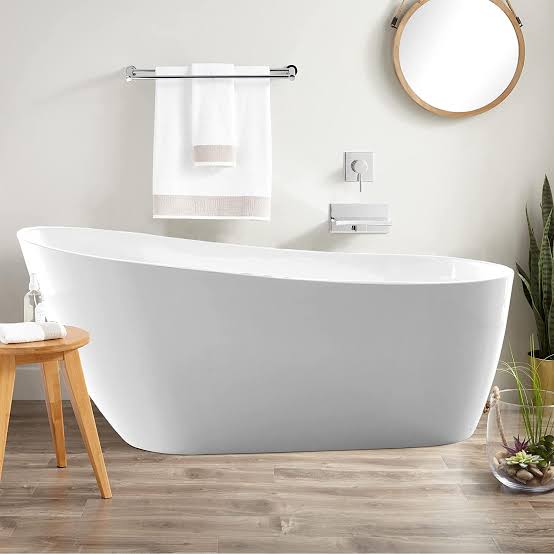
Requirements for Best Freestanding Tubs
The best freestanding bathtubs typically require a reasonable amount of investment, so it’s important to consider the necessary determining factors before making a purchase. Key factors to keep in mind are stylish design, suitable material, multiple functions, and easy maintenance.
Stylish Design
There are several styles and designs of freestanding bathtubs to select from, such as single-ended tubs, single-slipper tubs, double-ended tubs, double-slipper tubs, claw-foot tubs, and Japanese soaking tubs.
- Single-ended tub: One end is sloped and rounded, which makes it great for reclining against. The other end is straight squared-off, making it great for drain and faucet installation.
- Single-slipper tub: Similar to single-ended tubs, except that one end is elevated instead of sloped. The elevated end serves as a back support for people who prefer to sit in the tub.
- Double-ended tub: Feature two sloped ends, making it comfortable for bathing on both sides. The walls are not elevated, allowing the user to lie back.
- Double-slipper tub: Raised on both ends, this design is big enough to accommodate two users like couples facing each other. These bathtubs have a low point in the middle for the drain, while the faucet is placed on one side.
- Claw-foot tub: This is a classic style that’s still somewhat common. It has 4 or more feet that are shaped like an animal’s paws. Instead of sitting on a pedestal base, they are designed to rest atop a ball. The downside of this style is that it’s very heavy and can damage the floor.
- Japanese soaking tub: This freestanding tub is specifically constructed for small spaces. It has the shortest length, however, it is quite high. Users sit instead of reclining, allowing for full submerging into the water up to the shoulder.
Suitable Material
There are various materials used to produce the most comfortable bathtubs. They include solid surfaces, acrylic, cast iron, fiberglass, stone, copper, stainless steel, porcelain, wood, and composite. Each of them has different characteristics and requires different degrees of care and maintenance. Before making a decision on the best free-standing tub, compare the properties of these materials and choose the one that offers more benefits.
But generally, the best material for making a freestanding bathtub is a solid surface. Solid surface bathroom solutions stand out because of their seamless and smooth surface, excellent heat retention, good durability, and sustainability.
Multiple Functions
Another salient requirement is the list of functions the best free-standing tub can perform, as they can enhance the bathing experience. The tub should have a convenient water system for a steady flow, as well as built-in faucets, handheld showers, and thermostatic controls for precise temperature adjustment.
Some freestanding bathtubs may have electronic controls, which allow users to operate various functions with the touch of a button. Other possible features are air jets or water jets that can change the bathtub into a spa-like oasis, providing flexibility, relaxation, and muscle relief.
Easy Maintenance
The last but not the least essential requirement for choosing the most comfortable freestanding tub is easy maintenance. Selecting tubs made with quality materials like solid surfaces, acrylic, fiberglass, or stone can make cleaning and maintenance a walk in the park. This is because these materials are resistant to stains, scratches, and discoloration.
Choosing bathtubs (Learn: How to Choose a Bathtub for Commercial Use) with smooth and seamless surfaces simplifies maintenance. Some may also have antimicrobial surfaces that resist the growth of bacteria, mold, and mildew, resulting in a more hygienic bathing environment.
A Versatile Material for Best Freestanding Tubs – Solid Surface
Are you looking for the most versatile material for freestanding tubs? Look no further than a solid surface. The material can be easily formed into any design, shape, color, and size.
Characteristics of Solid Surface Tubs
- Seamless and Smooth Surface: Solid surface bathtubs and accessories have seamless and smooth surfaces that are devoid of visible joints. This enhances their aesthetic appeal and makes them very easy to clean and maintain.
- Excellent Heat Retention: One of the notable features that best freestanding bathtubs should have is great resistance to heat. The solid surface has excellent heat resistance properties that allow the tub to maintain water temperature for longer periods. This improves the bathing experience by keeping the water warm throughout the bathing duration.
- Good Durability: Another factor that is important in selecting the best free-standing tub is longevity and continuous performance. Solid surface is resistant to stains, spills, scratches, and cracks, making it a very durable option. It can withstand regular use without signs of wear and tear.
- Sustainability: Solid surface bathtubs are made from a composition of natural minerals and resins, which makes them an eco-friendly option. Additionally, they can be repaired, refinished, and even recycled in order to minimize their impact on the environment.
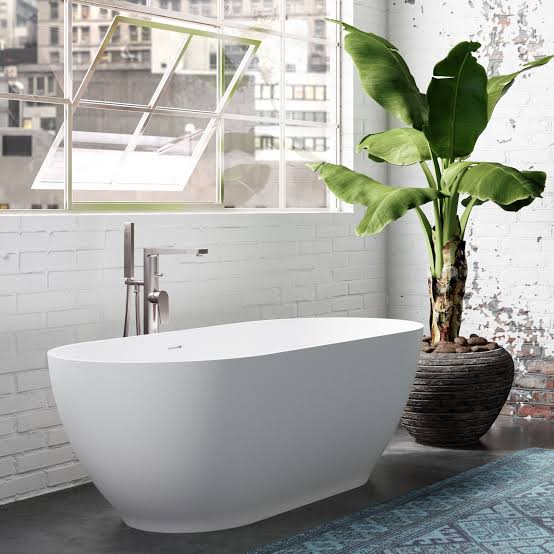
Care and Maintenance of Solid Surface Tubs
To ensure the durability and high performance of solid surface bathtubs, proper care, and maintenance are crucial. To get started, regularly clean the tub using a mild, non-abrasive cleaner that’s compatible with solid surface materials.
Note: Don’t use harsh cleaning solutions, chemicals, or scouring pads because they can damage the surface.
While solid surface tubs are generally resistant to stains and spills, it is best to quickly clean any impurities to prevent them from becoming difficult to erase. Wipe away substances like hair dye that may come in contact with the tub’s surface while bathing. Also, it’s advisable to avoid excessive force or impact because these tubs are prone to damage from heavy objects or sharp tools.
A Lightweight Material for Comfortable Freestanding Tubs – Acrylic
Acrylic is the material commonly used for making the most comfortable freestanding tub with a lightweight. Since it’s not heavy, less effort is needed for a change of position.
Characteristics of Acrylic Tubs
- Lightweight: The most notable feature of acrylic freestanding tubs is their lightweight nature, which makes them very easy to handle and install. This also gives room for more flexibility in terms of placement within the bathroom.
- Heat Retention and Resistance to Cracks: Acrylic materials are good at ensuring that the bathwater stays warm for longer periods, allowing the user to have a more comfortable bathing experience. Acrylic tubs are also resistant to cracks, making them last longer.
- Affordable: Acrylic materials are cheap, making the bathtubs a more cost-effective choice for people seeking the most comfortable freestanding tub without breaking the bank.
Care and Maintenance of Acrylic Tubs
To care for and maintain acrylic bathtubs, use a mild cleaner specifically made for acrylic surfaces. Don’t use strong solvents, abrasive cleaners, or chemicals, as they can result in damage or color fading. Rather, use gentle, non-abrasive cleaning products. Apply them using a soft cloth or sponge and gently wipe the tub’s surface to remove impurities.
Next, rinse the tub thoroughly using warm water to remove all cleaning residue. Then, dry the tub with a soft, neat cloth to avoid water spots or mineral buildup.
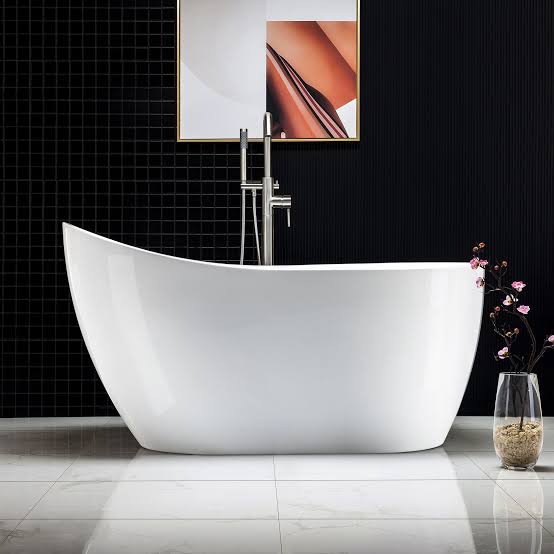
A Long-Lasting Material for Comfortable Freestanding Bathtubs – Cast Iron Tubs
While cast iron tubs are not very popular today because they are heavy and difficult to move, they are preferred by some people because of the guarantee to last long.
Characteristics of Cast Iron Tubs
- Long-Lasting: Cast iron has the reputation of being the most durable material for the best freestanding bathtubs. Cast iron tubs have a solid construction that can withstand heavy use and resist wear and tear over time. With proper care, they can last for decades.
- Weighty: Cast iron tubs are heavy, hence they are not very portable. However, their heaviness gives a substantial and luxurious feel. The weight also helps with heat retention, as the material absorbs and retains heat, keeping the bathwater warm for longer periods.
- Quite Expensive: Cast iron tubs are more costly than other types of materials, and this is because of their craftsmanship and labor cost.
Care and Maintenance of Cast Iron Tubs
To clean cast iron tubs properly, use mild, non-abrasive cleaners that are compatible with cast iron. Avoid strong acids, bleach, ammonia, or other harsh chemicals, as they can damage the tub’s surface and strip off its protective coating, which will result in discoloration.
Promptly address any chip or scratch on the tub’s surface to prevent rust from forming. Also, apply touch-up enamel or sealants to protect the exposed areas.
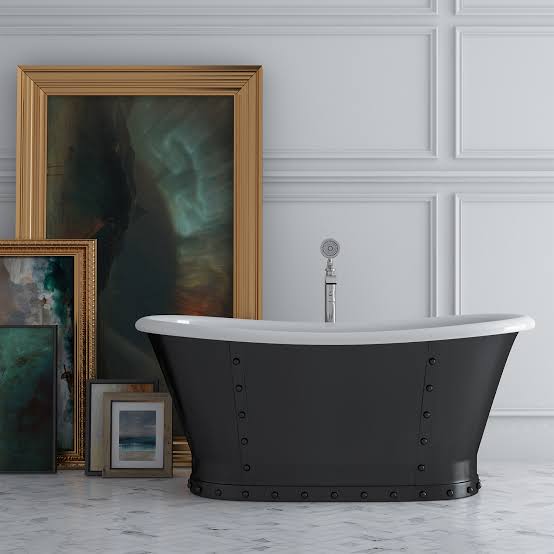
A Durable Material for Freestanding Tubs – Fiberglass
Fiberglass is one of the most comfortable bathtubs that can be referred to for durability. The material supports resistance to spills, stains, and fading, which makes it a favorite for some people.
Characteristics of Fiberglass Tubs
- High Resistance to Stains and Discoloration: The non-porous nature of fiberglass makes the tubs less susceptible to absorbing and retaining stains, which makes cleaning and maintenance easier. Also, fiberglass free-standing bathtubs come with a protective gel coating that helps preserve their color and prevent discoloration.
- Lightweight: Fiberglass is a lightweight material, making the bathtubs relatively easy to carry. This results in ease of installation and greater versatility in placement within the bathroom.
- Lack of Heat Retention: Compared to some other materials like solid surface and cast iron, fiberglass best freestanding tubs have less heat retention. While this means that the water temperature may cool down faster, it is beneficial for individuals who prefer cooler baths or want the flexibility to switch water temperatures more easily.
Care and Maintenance of Fiberglass Tubs
It’s crucial to avoid using harsh chemicals or abrasive cleaners, as they can spoil the bathtub’s surface and potentially cause scratches. Rather, use mild, non-abrasive cleaners that will effectively remove dirt and grime without damaging the bathtub.
Additionally, the tub should not be exposed to direct sunlight for a long period, as this can cause it to fade quickly. And if the tub is installed near a window, consider using curtains or blinds to reduce the sun effect.
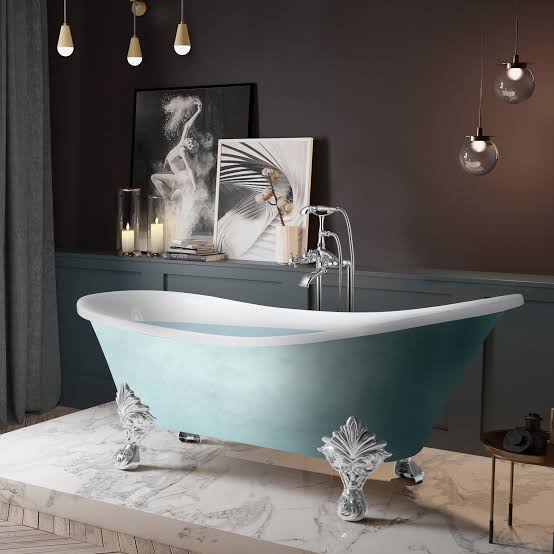
A Durable Material for Freestanding Bathtubs – Stone
Stone is unarguably one of the trendy bathtub materials for 2023. It is popularly known for its uniqueness and luxurious appeal, making the freestanding bathtubs a sight to behold.
Characteristics of Stone Tubs
- Natural Veining: Stone freestanding tubs are naturally beautiful with the display of unique veining patterns. These organic variations make each bathtub one-of-a-kind, with the inclusion of a touch of elegance and sophistication to any bathroom décor.
- Durability: They are tough and can withstand the test of time. Their solid construction offers excellent strength and resilience, ensuring that the bathtub remains in good condition despite frequent use.
- Heat Retention: The heat retention ability of stone tubs is exceptional. The natural density of the stone material allows for the absorption and retaining of heat, resulting in a soothing and comfortable bathing experience for longer periods.
Care and Maintenance of Stone Tubs
Stone tubs require proper sealing to protect the surface from water absorption and stains. Applying a high-quality stone creates a protective barrier, which helps preserve the tub’s appearance.
To further maintain the bathtub’s look, it is essential to avoid the use of strong chemicals, including cleaning agents containing bleach or ammonia.
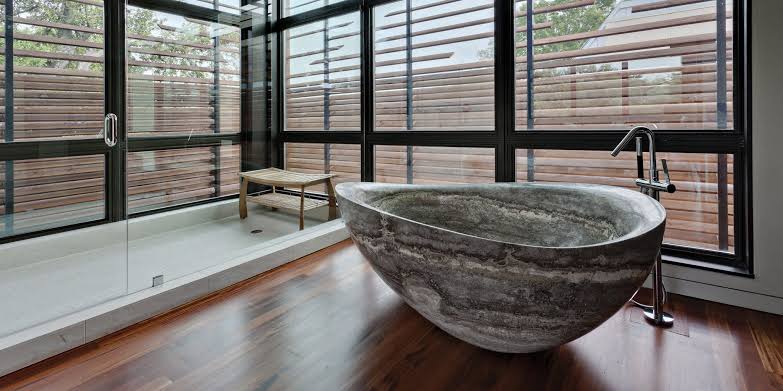
A Nice-Looking Material for Freestanding Tubs – Copper
Aside from the fact that copper bathing tubs are quite expensive and not recommended for people on a tight budget, the bathtubs have attractive finishes with high resistance to corrosion.
Characteristics of Copper Tubs
- Platina Development: One of the distinctive features of copper’s best freestanding tubs is the development of a natural patina over time. As copper reacts with the environment, it undergoes a beautiful aging process, involving a gradual change of color and the development of a unique, rich patina.
- Good Heat Conduction: Copper is an excellent conductor of heat, making it ideal for making the most comfortable bathtubs. It absorbs and retains warmth quickly, keeping the water at a cool temperature. This enhances relaxation and soothes the muscles.
- Anti-microbial Properties: Copper naturally inhibits the growth of bacteria, germs, and other harmful microorganisms, making bathtubs a hygienic option for bathrooms. The material helps ensure a clean and healthy bathing condition.
Care and Maintenance of Copper Tubs
Copper tubs develop a tarnish over time, to restore their shine and luster, gently clean them with a copper polish or a mixture of lemon juice and salt. To prevent scratches or damage to the tubs’ surface, avoid placing sharp objects or heavy items on them.
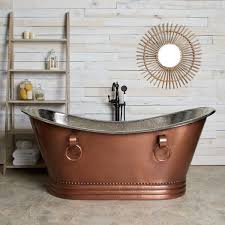
A Sleek Material for Freestanding Bathtubs – Stainless Steel
Freestanding bathtubs made from stainless steel are renowned for their modern and sleek look. Also, they are very easy to clean and maintain. They are unarguably one of the most comfortable bathtubs.
Characteristics of Stainless Steel
- Lightweight: Stainless steel is a lightweight material, making the tubs easy to handle, install, and move around for better placement within the bathroom.
- Resistance to Corrosion: The material is highly resistant to corrosion; it’s less susceptible to rust or stains, ensuring that the bathtub retains its pristine look at all times.
- Durability: Stainless steel bathtubs are known for their longevity. They can withstand regular use without showing signs of wear or tear. Also, they don’t scratch, stain, chip, or retain odor.
Care and Maintenance of Stainless Steel
Stainless steel usually has a visible grain or polish line, so when cleaning, it’s recommended to wipe in the direction of these lines using a soft cloth. This will help maintain the bathtub’s appearance and avoid leaving streaks or marks.
And after cleaning, rinse the tub thoroughly with warm water to remove any residue. This is to erase the remains of soap or mineral deposits on the tub’s surface.
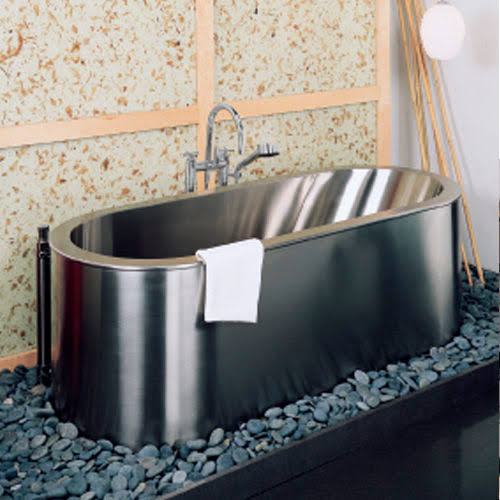
A Glossy Material for Freestanding Tubs – Porcelain
Porcelain is one of the materials used by top bathtub brands in 2023 because of its shiny and glossy look. They can easily blend with any luxury setting and they guarantee longevity.
Characteristics of Porcelain Tubs
- Smoothness and Glossiness: Porcelain bathtubs have smooth and glossy surfaces, which adds a touch of beauty to any bathroom. Their sleek and fine finish improves the visual appeal of the bathtub, creating a luxurious bathing experience.
- Resistance to Stains and Discoloration: This best free-standing tub material has high resistance to stains, making it very easy to clean and maintain. The tub’s non-porous surface avoids the absorption of dirt and grime, which makes it resistant to discoloration.
- Durability: Porcelain freestanding tubs can withstand frequent use without showing signs of wear and tear, making them a guaranteed choice for longevity.
Care and Maintenance of Porcelain Tubs
While porcelain tubs are durable, they are still prone to chips and cracks if they come in contact with heavy objects or sharp items. Be cautious when handling these objects or items around the bathtub. To further maintain the tub’s pristine look, when not in use, lay a non-slip mat or towel inside to protect it from accidental damage.
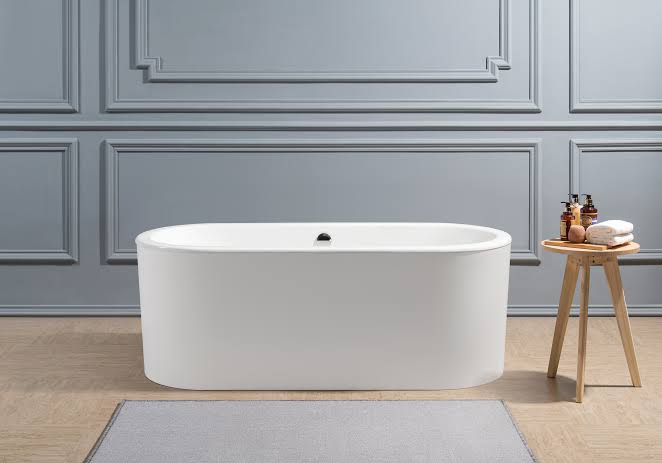
A Warm Material for Freestanding Bathtubs – Wood
Wood freestanding tubs are popularly known for their warmness and inviting touch. Even though they are not commonly used nowadays, their uniqueness is one-of-a-kind
Characteristics of Wood Tubs
- Natural Thermal Insulation: Wood is a natural insulator, meaning it has an innate ability to retain heat. Hence, wood-free standing tubs are capable of keeping the water warm for longer durations, providing a cozy bathing experience.
- Comfortable and Warm Touch: Wood offers a naturally warm and comfortable feel. Unlike other materials like fiberglass, wood tubs offer a soothing and pleasant sensation when touched.
- Aesthetic Appeal: Wood tubs boast of natural beauty, adding a touch of organic elegance to any bathroom. They are available in various grain patterns and colors, which make each wood tub a distinct piece of craftsmanship.
Care and Maintenance of Wood Tubs
Even though wood produces one of the most comfortable bathtubs, it’s susceptible to damage from prolonged exposure to water. To prevent it from warping, swelling, or rotting, it is important to avoid prolonged contact with water. The tub shouldn’t be left filled with water for extended periods.
Also, spills or splashes should be quickly wiped off to maintain aesthetic appeal.
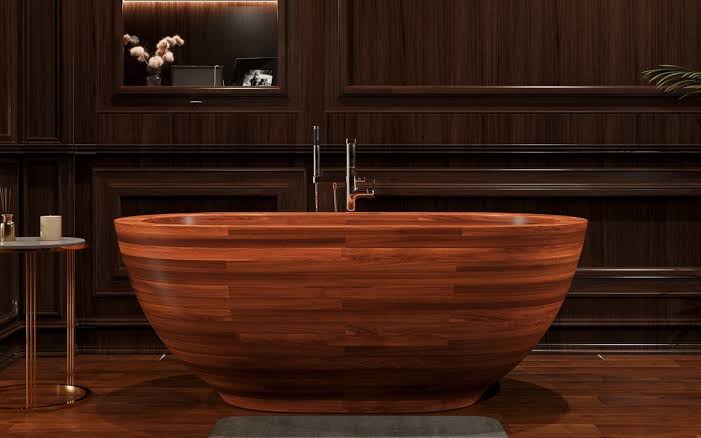
A Durable Material for Freestanding Tubs – Composite
This is the last but definitely not the least material for making the best freestanding bathtubs. Composite tubs are durable, and versatile, and offer excellent aesthetic options.
Characteristics of Composite Tubs
- Good Durability: Composite tubs are known for their durability and resistance to wear and tear. They are designed to withstand regular use without cracking, discoloring, or deteriorating in any form.
- Compatibility with Surrounding Materials: These best freestanding tubs are structured to seamlessly integrate with various surrounding materials like tiles, stones, or other composite elements. This allows for better design flexibility, resulting in a cohesive and aesthetically pleasing bathroom space.
- Aesthetic Options: Composite tubs are available in different styles, finishes, and colors, hence there are various options for different bathroom aesthetics. There are options for a modern-minimalist look, as well as a traditional look.
Care and Maintenance of Composite Tubs
Composite tubs are not very good at handling heat, so avoid placing hot items on them. Use a trivet or heat-resistant pad to protect the composite bathtub from high temperatures and potential damage.
Also, to ensure that the tub keeps looking appealing, clean it with a gentle, non-abrasive cleaner using a soft cloth or sponge. Pay more attention to the parts that require more cleaning. Then, rinse thoroughly with warm water to remove any cleaning residue.

Get the Most Comfortable Solid Surface Tubs from KKR
Looking for the most comfortable solid surface freestanding bathtubs? Look no further. KKR is a reliable producer and fabricator of solid surface tubs with over 23 years of experience. We offer a lot of benefits, including various customization options and large output capability.
Providing Customization Options
We make the best freestanding tubs, providing the opportunity to bring your ideas to life. There are various colors, patterns, styles, and designs to serve as a perfect match for your project. You can choose from our wide range of customization options, including 3000+ mature and mass-producible colors, 127+ texture patterns with 80% of them exclusive to KKR, and extensive designs.

Large Output Capability
Having a large production factory with many qualified staff and state-of-the-art machinery, including molds that are pasted with 15+ layers of glass fiber, we manufacture 500 sets of solid surfaces, which is twice the production of other manufacturers. Hence, we are capable of completing bulk and urgent orders within a limited time. Operating at 90% automation, quality won’t be compromised for every batch produced.
Conclusion
Freestanding tubs are great not just because of the convenience of bath and relaxation, but ease of installation and portability. They can be made with different materials, but in this post, we’ve highlighted the top 10 materials, their characteristics, and how they can be cared for and maintained to ensure visual appeal and longevity.
KKR is one of the best freestanding tub manufacturers using solid surface materials. They can be designed in various colors, patterns, and styles according to your requirements. We offer several value-added services, including a responsive team who are readily available to offer professional assistance. So if you are looking for the solid surface most comfortable bathtubs, contact us today to get started.



